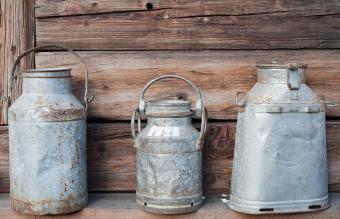
Metal milk cans can be a beautiful addition to any farmhouse kitchen or vintage farm collection, and learning how to date old milk cans is very useful. If you know how old the can is, you can get a better sense of its value.
Milk Can History
Used to transport milk from the cow to the home, some of these cans date back hundreds of years. The earliest metal milk cans are from the Island of Guernsey about 1,000 years ago, where they were made by hammering sheets of metal into a set form in the same way armor of the era was made. The design changed over time to create the standard shape you are likely to see in antique stores. The tapered top helped keep the milk from spilling during transport, especially during the 19th century when carts and wagons were the primary form of transport. Most examples you'll encounter are made from tin, steel, or copper. Milk cans fell out of common usage as dairy transport methods changed after the invention of refrigerated trucks.
How to Date Old Milk Cans
If you have an old milk can or are considering one in an antique store or flea market, there are some clues for establishing a date, according to Antique Trader. Follow these steps to determine how old your milk can may be.
Consider the Size
Older milk cans from the 19th century tend to be larger, often holding up to 25 gallons. If a milk can is this size, it likely dates to before 1920. Smaller milk cans, such as those that can hold five gallons, could be from any time in the 19th or 20th centuries.

Look for a Patent
Milk can designs changed frequently as farmers adapted them to better suit their needs. Many cans feature patent numbers, which offer an easy clue about date. Check the can over thoroughly for a patent number and then look the number up at the US Patent Office. You'll get a specific date that patent was issued.
Check for a Creamery Label or Farmer's Name
Many old milk cans include a label for the creamery that owned it or a small brass tag with the name of the farmer. Either of these can give you more information about the milk can's history, including an approximate age for it. Do a local search or contact the library in the town where the creamery was located. There may be records of the business that will give you a range of dates for the can.
Look at the Materials and Construction
Older milk cans are constructed from thicker metal, while new ones were made of thinner tin. Older cans also tend to be made of three pieces of metal that are welded together instead of a single piece of metal. Additionally, labels on older cans are thick paper instead of a thin sticker.
Check for Holes in the Cap
The cap of older milk cans from before 1920 often had several small holes to help vent steam from the warm milk as it cooled. These were eliminated in later cans.

Value of Antique Milk Cans
Many milk can collectors enjoy gathering cans from a specific region to create a collection. Others choose cans with painted images or cans made of copper. Value depends on what collectors are looking for, but most cans range from about $20 to well over $200. Condition is a big factor in value with cans in great shape with clear labels and minimal damage fetching the most. Here are a few sample values of what milk cans are worth:
- A small red-painted milk can in rough shape with no label sold on eBay for about $20.
- A simple galvanized steel 10-gallon milk can in excellent condition sold for about $85.
- A lovely polished copper milk can with brass handles and a creamery stamp sold for about $350.
Using Antique Milk Cans in Your Decor
If you enjoy decorating with antiques, milk cans are a great addition to your home. You can use them as a large vase for holding flowers or greenery or simply display them in a grouping as kitchen collectibles. Some people also use them as outdoor decorations, but exposure to the weather can cause damage over time. No matter how you choose to use them, they make a charming and functional antique with a pretty farmhouse flair. For more farmhouse antiques, learn about Atlas Mason jar values and how to date them.







